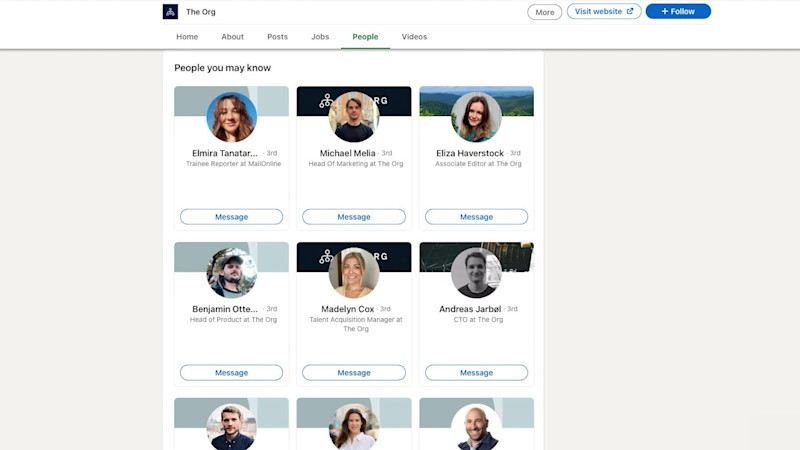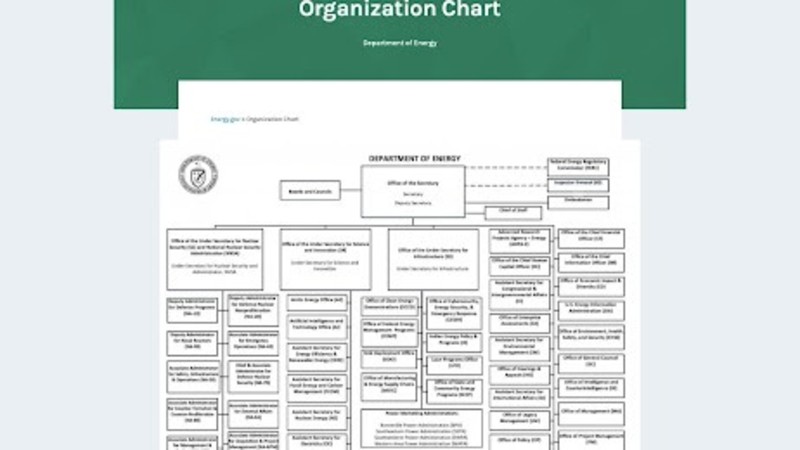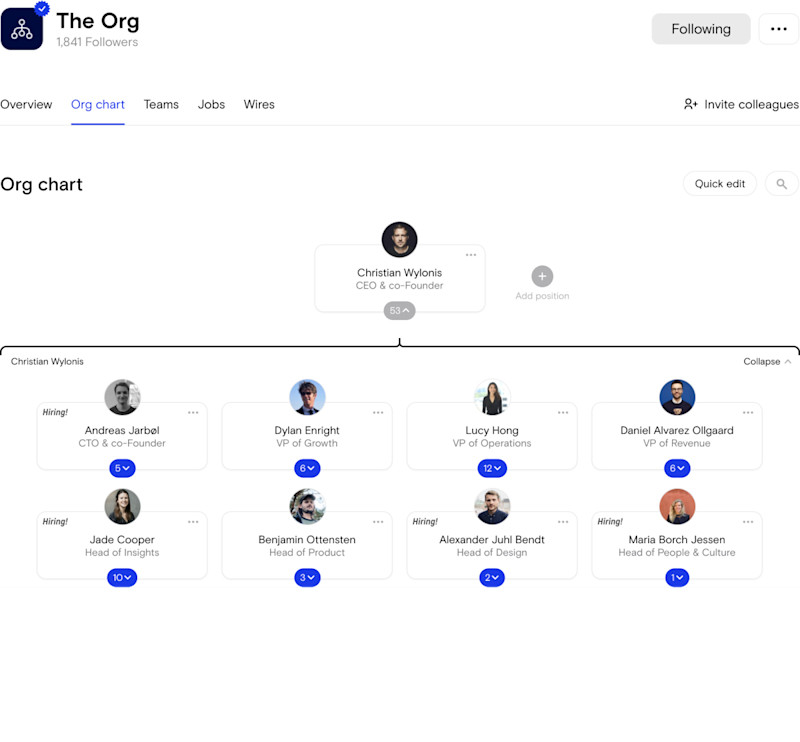- Iterate
- Organizational Structure
- How Studying Company Org Charts Can Give Your Startup a Boost
How Studying Company Org Charts Can Give Your Startup a Boost
Table of contents
In this guide, we tackle how other company's org charts can be a startup founder's best friend. Gain insights on company structure from thousands of tech company org charts for free on The Org.

One of the best kept secrets to building a great internal structure for your startup? Studying public org charts.
While most companies have some sort of internal org chart documenting all of their teams, employees and job responsibilites, most company org charts are difficult to find. Private companies and innovative startups see their organizational structure as part of their intellectual property and purposely hide this information.
But many companies see the benefits a public org chart can bring as well: diversity and transparency as essential tools for hiring the best talent, acquiring investment, and winning customer trust and loyalty. The Org has built a community with over 300,000 public org charts to browse from, from tech giants like Netflix and Amazon, to high-growth startups like Maze, dbt Labs, and Creative X.
In this guide, we'll go over:
- what info to look for in other company's org charts
- why studying org charts are helpful for startup founders
- where to find updated, accurate company org charts
Eager to learn more? Let's get started.
What info can I find on a company org chart?
An org chart is a visualization featuring two primary components: 1. The organizational structure 2. The people
The organizational structure
The organizational structure looks similar to a family tree. The structure is often hierarchical, featuring the CEO at the top, followed by the C-suite, VPs, managers, employees, etc.
The people
The second element is the people whose profiles typically include a name, title, and image—like this example from The Org. Internal org charts often have more details, like the individual's department, location, and contact information.
Why are company org charts useful for founders?
There are several reasons why people use company org charts. Here are six examples:
- Promoting and hiring: HR uses org charts to find possible candidates for promotion. They also use these charts for onboarding and building new teams.
- Cross-functional collaboration: teams often collaborate with other departments to deliver projects or win resources. Org charts help team members identify decision-makers and formal channels.
- Finding a job: job seekers use org charts to learn whether the people, positions, management, and structure align with their career goals and values.
- Event invites: org charts allow you to find relevant people and departments for events, workshops, and conferences—for example, finding UX designers, product managers, and front-end engineers for a design system workshop.
- Investing: investors often use org charts to research a company's decision-makers and leaders to understand their experience and competency.
- Consumer interest: many consumers want to know about their favorite brands and whether the organization's employees represent their values—for example, does the company live up to its diversity and inclusion claims?
Where can I Find Company Org Charts?
There are several places you can find company org charts. Our list includes sources for companies, colleges/universities, and government entities.
The Org
The Org has the largest and most comprehensive organization chart databases with over 300,000 companies (and counting). The Org's search feature allows you to filter by industry, country, and company size to narrow results.
Each company profile has five categories:
1. Overview: short bio, headquarters, website, company size, social links 2. Org Chart: the company's org chart, including board and advisors 3. Teams: the company's teams and departments 4. Jobs: job seekers can see available positions and apply via The Org 5. Wires: company announcements
The Overview tab also provides photos of the organization's operations and team-building events, company values, and insider experiences featuring reviews from past and present employees.
About sections
Some organizations publish their org chart in the about section of their website. These website org charts are usually limited to C-suite executives and board members, which doesn't give an accurate picture of the company's structure and departments.
Company websites are great for investor research but might not satisfy job seekers and people looking for more comprehensive visualization of the organization.
Company intranet
Many companies use intranet platforms for internal communication and collaboration. These platforms integrate with other tools to create a centralized productivity ecosystem.
Most intranet platforms offer an org chart feature so employees can network, identify decision-makers, and find contact information. They might also detail formal channels, so team members follow the correct protocols.
Human resources
HR is another internal resource for finding org charts. If a human resources department doesn't use an org chart software, they may have it in a document, spreadsheet, or other visualization.
The Official Board
The Official Board lists org charts for 80,000+ companies worldwide. Unlike The Org, The Official Board only features listed companies with charts limited to C-suite and management.
The Official Board doesn't show the entire org structure, requiring users to sign up and pay to view all the information. The user interface is not as user-friendly and intuitive as The Org, making it difficult to navigate.

LinkedIn doesn't have an org chart feature but includes a list of current employees on the People tab of a company profile page. While LinkedIn provides each person's profile with an image, name, and title, the list is often unordered and doesn't provide any organizational structure.
If you're looking to network with people at a specific organization, we recommend using The Org to search for the correct individual and reach out via LinkedIn.
Government websites

Most government departments (city, state, and federal) publish their organizational charts for transparency. Companies and startups often use government org charts to find decision-makers when applying for grants.
For example, if your startup is looking for funding for a new green energy project, you might use the DOE's organization chart to find the correct department or individual.
Wiki Profile
Wiki Profile is another org chart platform. While Wiki Profile claims to have millions of company listings, most company profiles are incomplete and don't provide org charts.
For example, you would expect one of the biggest global financial services providers, JPMorgan Chase, to have a comprehensive profile on Wiki Profile, but the page doesn't list a single employee.
Search engines
If these other sources fail, search engines like Google and Bing are also helpful for finding org charts for specific companies—i.e., using the search team company x org chart. This method requires more time and patience because you may have to click on a few results or modify your query.
Create your own free org chart today!
Show off your great team with a public org chart. Build a culture of recognition, get more exposure, attract new customers, and highlight existing talent to attract more great talent. Click here to get started for free today.
In this article


The ORG helps
you hire great
candidates
Free to use – try today
